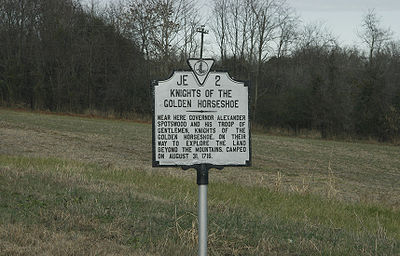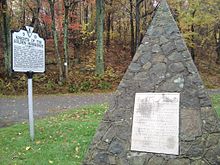- Knights of the Golden Horseshoe Expedition
-
The Knights of the Golden Horseshoe Expedition took place in 1716 in the British Colony of Virginia. The Royal Governor and a number of prominent citizens traveled westward, across the Blue Ridge Mountains on an exploratory expedition. It is a frequently recounted event of the History of Virginia.
Contents
The expedition
Alexander Spotswood became acting royal governor of Virginia in 1710, by which time pressure on the colony to expand had become more acute than ever. In 1716, Governor Spotswood, with about 50 other men and 74 horses, led a real estate speculation expedition up the Rappahannock River valley during westward exploration of the interior of Virginia. The journalist of this expedition was a Huguenot, Lieut. John Fontaine, who served as an officer in the British Army.
The party included 14 rangers and 4 Meherrin Indians, and departed Germanna on August 29, coming within sight of the Blue Ridge Mountains in the 31st. They continued upriver past today's Stanardsville, reaching the head of the Rappahannock on September 2. Fontaine recorded in his journal for September 5 that axemen had to clear the way along the path of what he called the "James River", but which was in fact a creek along the eastern slope named Swift Run, surrounded on all sides by steep mountain terrain. Swift Run is part of the James River drainage system. The expedition had followed the Rappahannock drainage system up to this point.
There they crossed the top ridge of the Blue Ridge mountains at Swift Run Gap (elevation 2,365 feet).
On September 6, 1716, they rode down into the Shenandoah Valley on the east side of Massanutten Mountain and reached the Shenandoah River, which they called the "Euphrates" near the current town of Elkton. There, they fired multiple volleys and drank special toasts of wine, brandy, and claret to the King and to Governor Spotswood, naming the two peaks after them.[1] The taller summit they called "Mount George", and the lesser, "Mount Spotswood".
On the banks of the river they buried a bottle, inside which they had put a paper whereby Spotswood claimed the place in the name of George I. On the 7th, the party returned home, reaching Germanna on the 10th.
After the journey, Spotswood gave each officer of the expedition a stickpin made of gold and shaped like a horseshoe on which he had inscribed the words in Latin "Sic jurat transcendere montes", which translates into English as "Thus he swears to cross the mountains." The horseshoes were encrusted with small stones and were small enough to be worn from a watch chain.[2] The members of Governor Spotswood's expedition soon became popularly known as the "Knights of the Golden Horseshoe."
Of the expedition members, only the following are known by name to have taken part: Lt. Governor Spotswood, John Fontaine, Robert Beverley, Jr., William Robertson, Dr. Robinson, Mr. Todd, James Taylor (great-grandfather of US President Zachary Taylor), Robert Brooke (grandfather of VA Governor Robert Brooke), George Mason III, Capt. Smith, William Clopton, Jr., (second son of William Clopton and Ann Booth Clopton)and Jeremiah Clouder.[3]
In a Richmond news article, dated 16 Feb 1901, honoring John Bacon Clopton, the grandson of William Clopton Jr.. The following is a copy of a handwritten statement, signed and sealed to be found among the John Bacon Clopton papers at Duke University Library, Durhan, North Carolina: There was in my father's possession a golden horseshoe which the tradition of the family said was worn by William Clopton Jr.. That is had 7 Diamonds set in it the place of nailheads, was inscribed on one side "Sic Juvat Trancsenderi Montes" and on the other "William Clopton, Knight." That as a child I have had it laid in my hand to look at and that it was of a size to encircle the center of my palm. And that this horseshoe was stolen by Pickpocket Smith, a notorious character, who operated among fashionable of Richmond in 1842 or 3. Witness my hand and seal this ninth day of August, 1897. Signed: Joyce Wilkinson Wallace
Heritage
When Spotswood returned to Williamsburg, he actually claimed that the intention of the Expedition was to look for a way to Lake Erie, with a view to eventually thwarting the growing French presence in the region. He also sought permission from Britain to make a second expedition to scout for an outpost location on the Great Lakes, however he never received it.[4]
At a practical level, word of the expedition, and descriptions of the fertile valley land beyond the mountain range, apparently didn't do much in the short-term to open the Shenandoah Valley for development from the east. The mountain range was a formidable barrier. Instead, most of the early settlers came down the Valley from the north, many of German and Scottish descent. Groups of Mennonites migrated from Pennsylvania, and settled in the general area of present-day Rockingham County and Harrisonburg, where their descendants may still be found today.
Spotswood's expedition, which from all reports, traveled at a leisurely pace, encountered little or no loss of life or conflict with Native Americans, and included frequent stops for celebrations and libations, earned a somewhat legendary status. The expedition's fame can also be attributed to providing further evidence supporting Virginians' self-image as being hospitable and loving of drink and conviviality. The fame was further enhanced when it was romanticized in The Knights of the Golden Horse-Shoe, an early chivalric romance, authored by William Alexander Caruthers, and first published in 1845.
Historic marker
A commemorative plaque and pyramid-shaped stone at Swift Run Gap (at the south side of U.S. Highway 33 near the Skyline Drive overpass) mark the historic crossing of the Knights of the Golden Horseshoe.[5] The Skyline Drive and the Appalachian Trail both pass nearby as well.
Also at this location, a Virginia Historical Highway Marker, # D10 Knights of the Golden Horseshoe, is located. It reads:
On 5 Sept. 1716, in this region, it is believed Lieutenant Governor Alexander Spotswood and his party of government officials, gentry, Native Americans, soldiers, and servants crossed the Blue Ridge Mountains into the Shenandoah Valley. Their adventure into Virginia's western lands began at Germanna late in Aug. and ended when they returned there on 10 Sept. According to legend, Spotswood gave his companions small golden horseshoes on their return and the group became known as the Knights of the Golden Horseshoe. The journey has been fictionalized and mythologized in literature since the 19th century.
Modern usage of Knights of the Golden Horseshoe
In modern times, the Knights of the Golden Horseshoe are those U.S. Army soldiers from the 100th Regiment recognized by their commanders for exemplary service and leadership, just as Governor Spotswood recognized the men in his 1716 expedition. Today's Knights of the Golden Horseshoe receive a small gold-painted horseshoe. They also are approved to wear a distinctive unit insignia, featuring a golden horseshoe emblazoned on a red shield. Originally approved for the 375th Field Artillery Regiment on April 27th, 1933, the insignia was redesignated for the 100th Regiment on July 8, 1960. A coat of arms also exists for regiments and separate battalions of the U.S. Army Reserve: this coat of arms features the golden horseshoe emblazoned on a red shield, the red symbolizing Artillery. Over the shield stands a Lexington Minute Man Proper.
In West Virginia, there is a competition named after the Golden Horseshoe(s). Since 2008, all 8th grade students take a test online to show their knowledge of West Virginia's history. The students with the highest scores are "knighted" and receive a golden horseshoe in Charleston, West Virginia, the state capital. Before 2008, the top scorers in the school-level pretest continued to take a county-level test. The students with the highest scores from this test were then "knighted".Notes
- ^ UVA Tour Guide
- ^ Campbell, p. 389-90.
- ^ John Gwathmey, 1937, Twelve Virginia Counties p. 400.
- ^ Gwathmey, p. 400.
- ^ Commemorative Plaque
References
- Marshall, Henrietta Elizabeth (1917) This country of ours; the story of the United States New York, George H. Doran Company
- Campbell, Charles (1860). History of the Colony and Ancient Dominion of Virginia. Philadelphia: J.B. Lippincott and Co.
External links
- Virginia Places web site a large site with lots of educational information about the Geography of Virginia
Categories:- Colonial Virginia
- 1716 in the Thirteen Colonies
- 1716 in science
Wikimedia Foundation. 2010.


